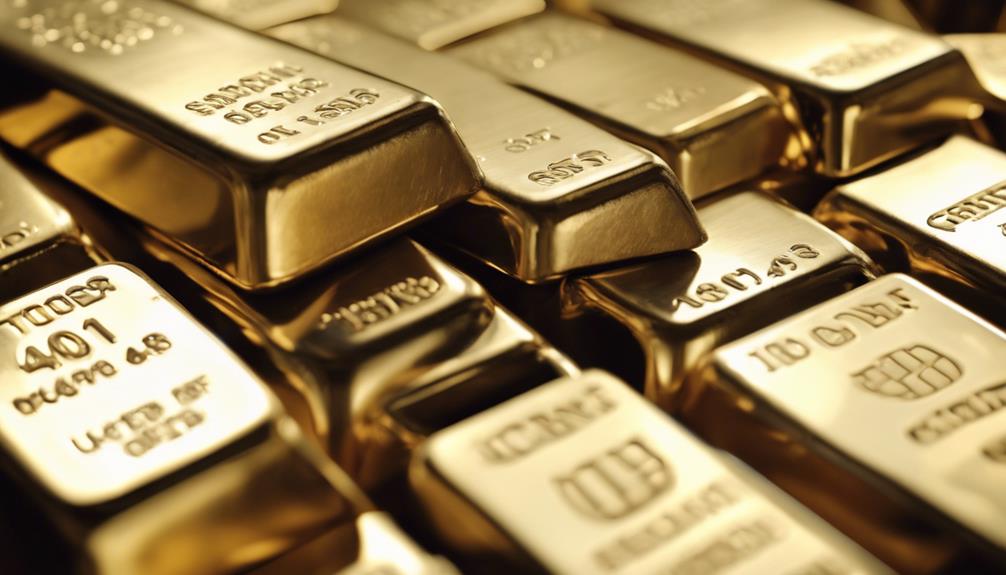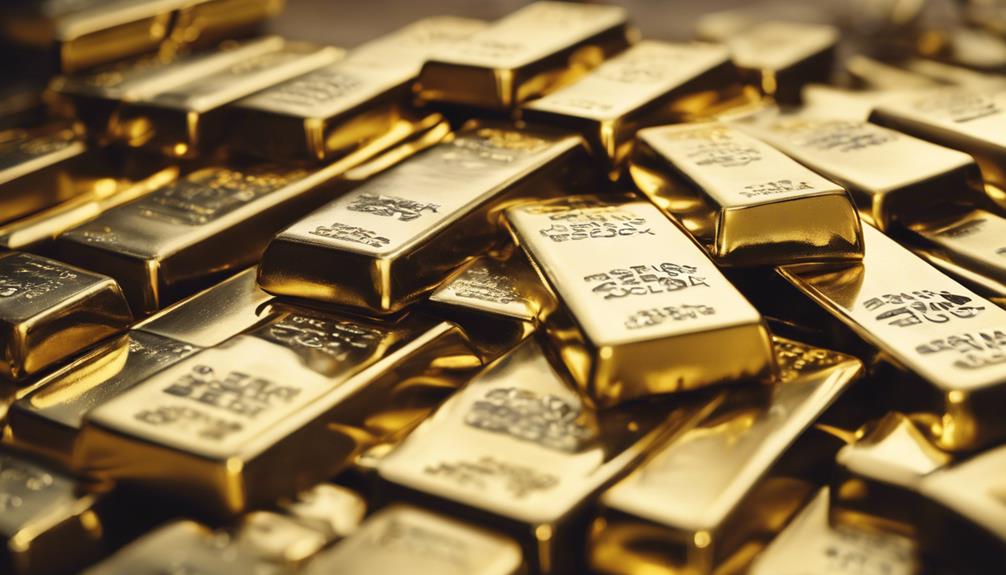Understanding the regulations for precious metals in IRAs involves strict purity standards. Gold must be at least 99.5% pure, while silver needs to be 99.9% pure. Platinum and palladium must be 99.95% pure. Approved forms for IRAs include bullion coins and bars. Eligible metals range from gold to palladium, providing tax advantages and diversification potential for your IRA. Understanding approved metals for investment can enhance portfolio diversification and protect against market fluctuations. Further details on metal eligibility and benefits await.
Key Takeaways
- Gold, silver, platinum, and palladium are approved for IRAs.
- Metals must meet specific purity and fineness standards.
- Approved forms include coins and bars from accredited sources.
- Metals like American Eagle and Australian Koala coins are eligible.
- Diversification, tax advantages, and portfolio protection are key benefits.
Eligible Precious Metals for IRA
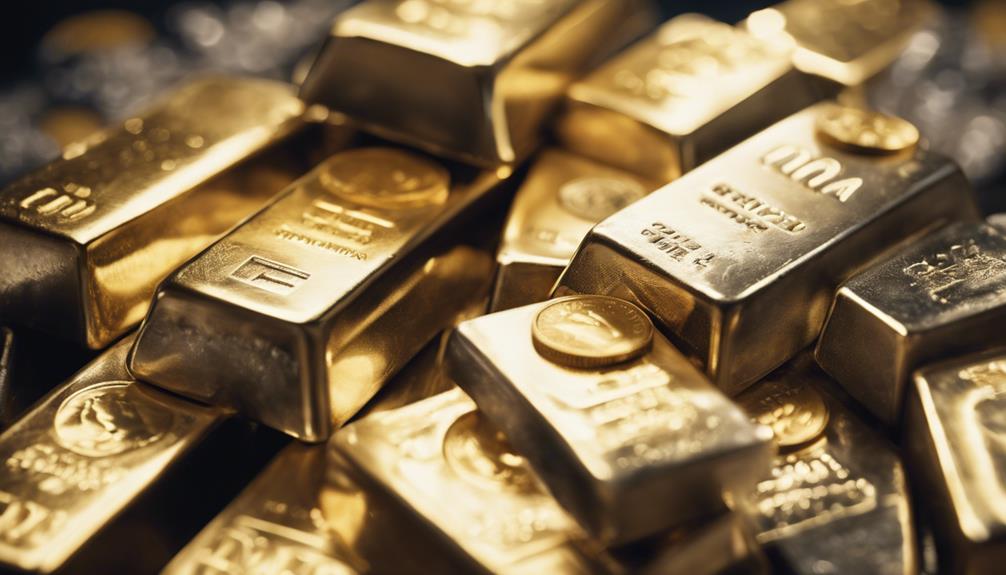
When considering eligible precious metals for an Individual Retirement Account (IRA), it is essential to understand the purity requirements set forth by the regulations. Precious metals such as gold, silver, platinum, and palladium can be included in an IRA, but they must meet specific criteria to qualify. Gold, for instance, must have a minimum fineness of 99.5% to be eligible for an IRA. Silver, on the other hand, needs to be at least 99.9% pure to meet IRA requirements. Platinum and palladium have even stricter purity standards, needing to be 99.95% pure to be considered for an IRA investment.
When it comes to the forms of these precious metals that are accepted in an IRA, approved products include bullion coins and bars. For gold, popular choices include American Eagle, Australian Kangaroo, and Austrian Philharmonic coins. Silver options consist of American Eagle, Australian Kookaburra, and British Britannia coins, among others. These products not only meet the minimum fineness requirements but also offer investors a diverse selection of IRA-approved precious metals to choose from.
Gold IRA Requirements
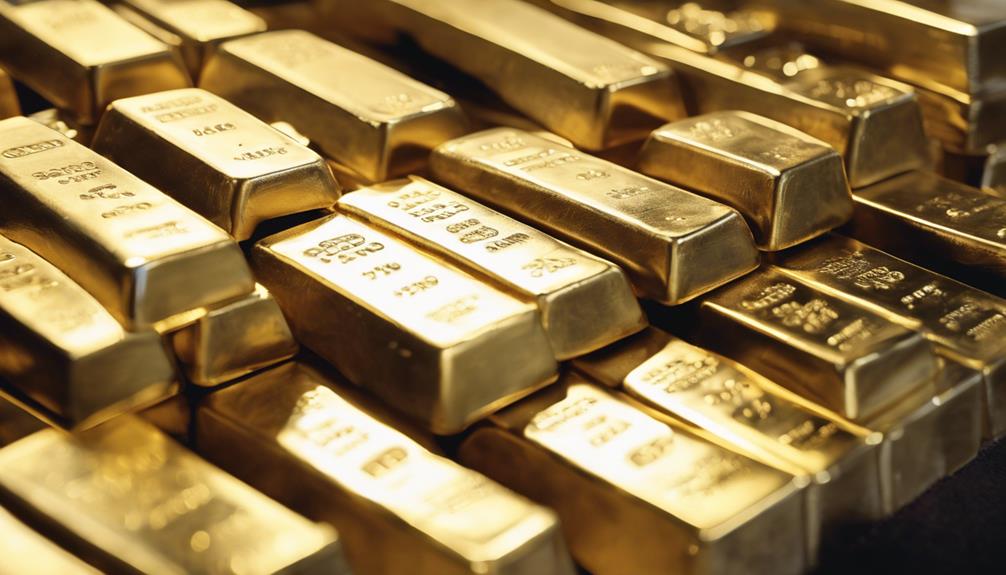
When contemplating a Gold IRA, it is vital to verify that the gold meets the purity requirement of 99.5% and that proof gold coins are in their original mint packaging.
Documentation proving the authenticity and purity of the gold is essential for compliance with IRA regulations.
Understanding these requirements is key to successfully incorporating gold in your retirement investment portfolio.
Eligibility for Gold IRA
To be eligible for a Gold IRA, the gold must be at least 99.5% pure and sourced from accredited refiners or mints. This condition guarantees that the gold meets minimum fineness standards, making it suitable for inclusion in an IRA account.
Gold bullion bars and coins that meet these criteria are considered IRA eligible, such as American Eagle, Australian Kangaroo/Nugget, and Austrian Philharmonic coins. Gold bars weighing up to 400 ounces are also acceptable for a Gold IRA.
Additionally, proof gold coins must be in their original mint packaging to qualify for inclusion in an IRA account. By abiding by these guidelines, investors can be confident that their gold holdings meet the necessary requirements for a Gold IRA.
Documentation Needed
For Gold IRA requirements, proper documentation verifying the purity level of the gold investment is essential. Gold allocated to an IRA must meet strict purity requirements, typically set at 99.5% purity.
When investing in a gold IRA, it is vital to make sure that the gold products chosen are approved for such accounts. Approved products may include American Eagle coins and specific gold bars.
Additionally, the documentation accompanying gold IRA investments must clearly verify the purity level of the gold being held. It is also important to note that gold eligible for IRAs must be sourced from accredited refiners or mints to guarantee its quality and authenticity.
Investors should diligently check the origins and purity of their gold investments to comply with IRA regulations.
Silver IRA Options
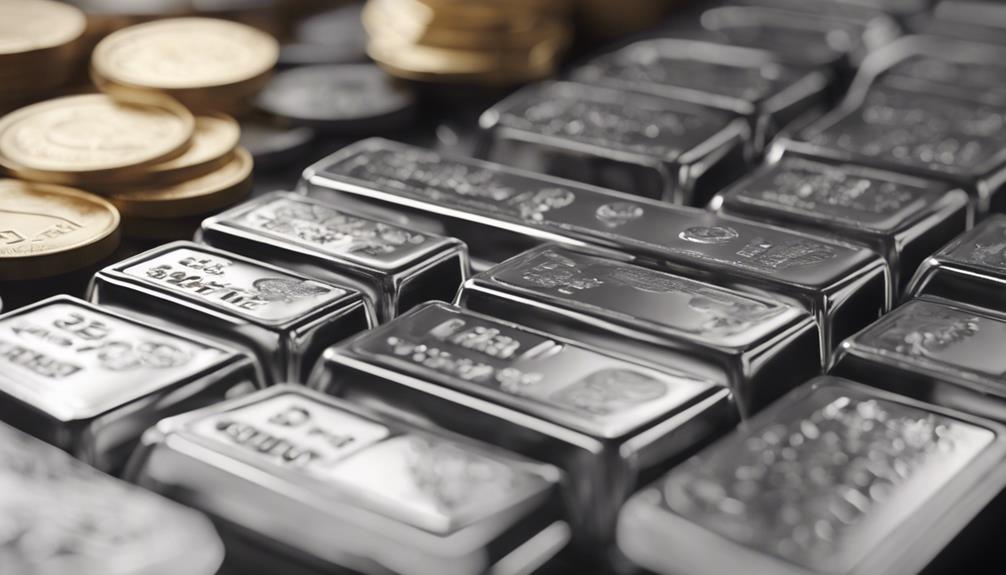
Silver IRA options encompass a range of approved precious metals, including renowned coins like American Eagle, Australian Kookaburra, British Britannia, and Mexican Libertad, as well as silver bars meeting a minimum fineness requirement of 99.9% purity. Investors seeking to diversify their IRA with silver can choose from a variety of popular coins such as the American Eagle and Australian Kookaburra, known for their quality and liquidity in the market. These coins, along with the British Britannia and Mexican Libertad, are among the options eligible for inclusion in a Silver IRA. Additionally, silver bars from accredited refiners or mints, provided they meet the 99.9% purity standard, are also acceptable for IRA investment. Ensuring that the silver products held in an IRA are from the IRS's pre-approved list is vital to maintaining compliance with regulations. Below is a table highlighting some popular silver options for IRA investments:
| Silver Option | Purity Level | Notable Features |
|---|---|---|
| American Eagle | 99.9% | Iconic design |
| Australian Kookaburra | 99.9% | Limited annual mintage |
| British Britannia | 99.9% | British legal tender |
| Mexican Libertad | 99.9% | Depicts Mexico's history |
Platinum IRA Considerations
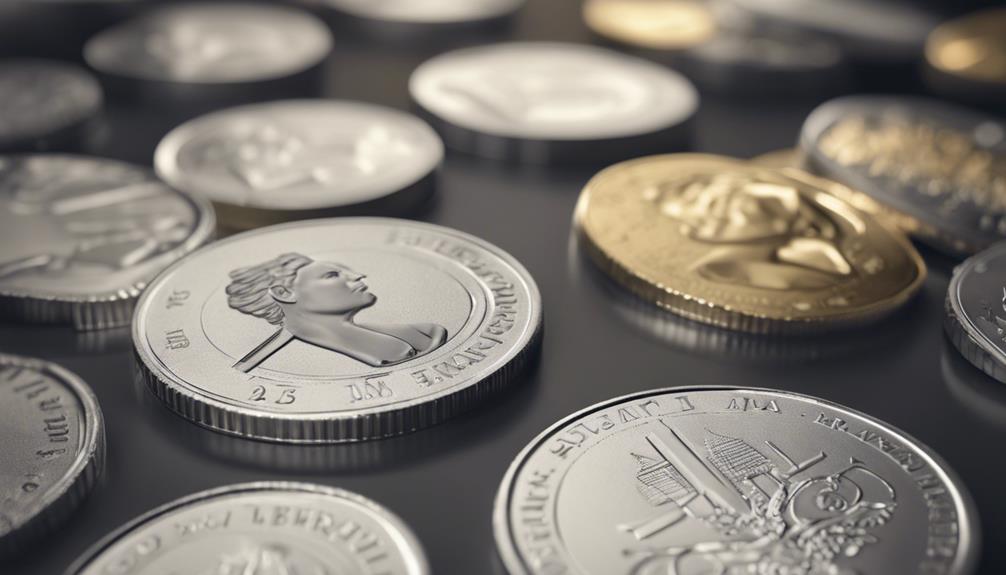
When considering diversifying an IRA beyond silver investments, platinum offers a valuable alternative with specific purity and weight requirements for eligibility.
To be included in an IRA, platinum must have a purity of at least 99.95%. Approved platinum products for IRA investment include coins like the American Eagle, Australian Koala, and Isle of Man Noble coins. Additionally, platinum bars with a minimum fineness of 99.95% are accepted for IRA inclusion.
Investors looking to add platinum to their IRA can choose from a range of weights, starting from 1/10 ounce up to 1 ounce.
When setting up a Platinum IRA, it is essential to make sure that the selected products meet the purity and weight standards mandated for IRA eligibility. By adhering to these requirements, investors can confidently diversify their retirement portfolio with platinum, a precious metal known for its rarity and industrial applications.
Palladium IRA Benefits
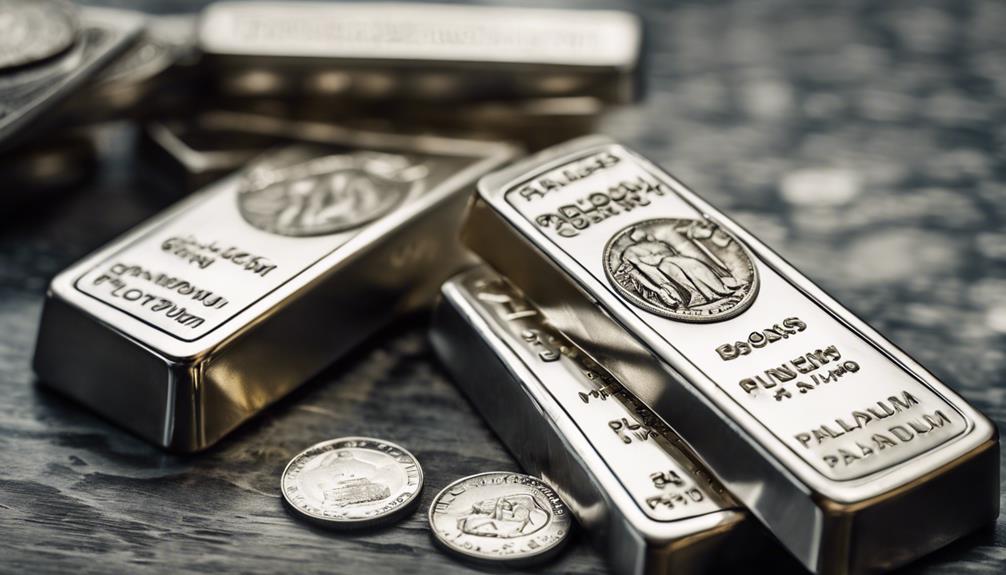
A Palladium IRA offers tax advantages and the potential for portfolio diversification through investing in this precious metal. By including palladium in your IRA, you can take advantage of its unique characteristics as a store of value and a hedge against economic uncertainty.
Understanding the benefits of a Palladium IRA can help investors make informed decisions about their retirement savings strategy.
Tax Advantages of Palladium
Among the array of tax-advantaged options available for investors, Palladium IRA stands out as a compelling choice due to its favorable tax treatment and potential for tax-free earnings accumulation.
Similar to other precious metals IRAs, Palladium IRA offers investors the opportunity to accumulate earnings tax-free within the account. There is no limit on the number of IRA accounts one can have to invest in palladium, with a maximum yearly contribution of $6,000, or $7,000 for individuals aged 50 and above.
To maximize the benefits of a palladium IRA, seeking advice from a tax specialist is recommended to understand IRS rules and make sure proper utilization of the tax advantages associated with investing in palladium through an IRA.
Portfolio Diversification With Palladium
Diversifying a Precious Metals IRA with palladium offers investors a unique opportunity to enhance their portfolio with an alternative asset known for its distinct properties and potential benefits. Palladium joins the ranks of gold, silver, and platinum as an IRA-eligible metal, requiring a minimum fineness of 99.95%.
Its appeal lies in the diversification it brings to an investment portfolio, especially for those seeking alternative assets with potential for growth. Opening a Palladium IRA allows investors to include physical palladium, further broadening their retirement asset mix.
With Palladium IRA rules permitting transfers from other retirement accounts without a maximum dollar limit, investors can strategically allocate funds to capitalize on palladium's unique market dynamics and potential long-term gains.
Precious Metals IRA Rules
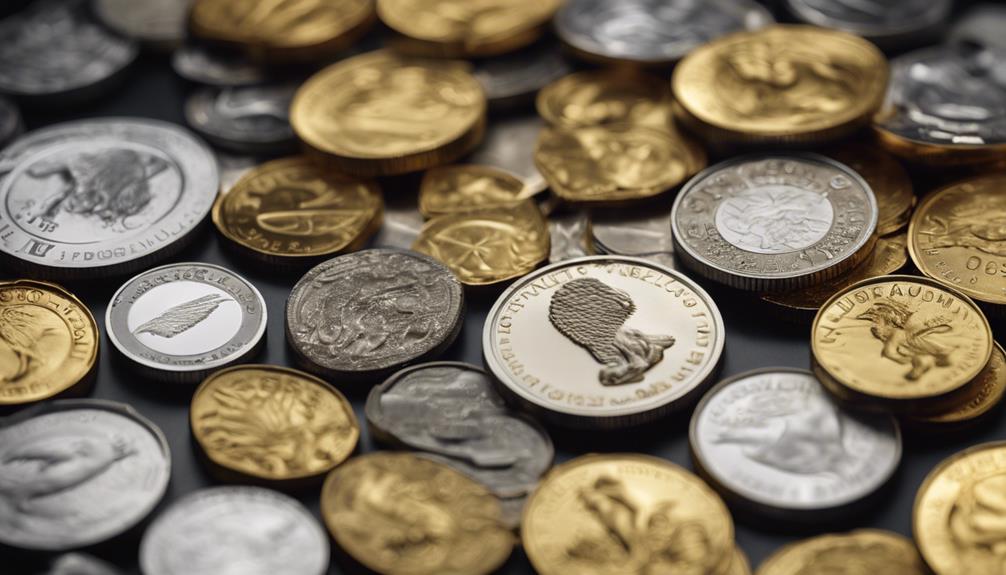
Adhering to stringent purity requirements is paramount when considering precious metals for an IRA investment. The Precious Metals IRA rules dictate that gold must be at least 99.5% pure, silver at 99.9% pure, and platinum and palladium at least 99.95% pure to qualify.
Approved gold investments for IRAs should consist of pure 24-karat gold bullion bars, while silver investments must be selected from a pre-approved list. IRA allowable precious metals encompass a variety of coins like American Eagle, Australian Kangaroo/Nugget, and Canadian Maple Leaf, in addition to other products meeting the minimum fineness standards.
To adhere with IRS regulations, individuals should refer to publications 590-A & 590-B to understand the approved precious metals suitable for their IRA. The eligible weights for IRA precious metals vary, ranging from 1/10 ounce to 1 ounce for coins and up to 400 ounces for gold bars, 1,000 ounces for silver bars, 50 ounces for platinum bars, and 100 ounces for palladium bars.
Approved Metal Weights for IRA
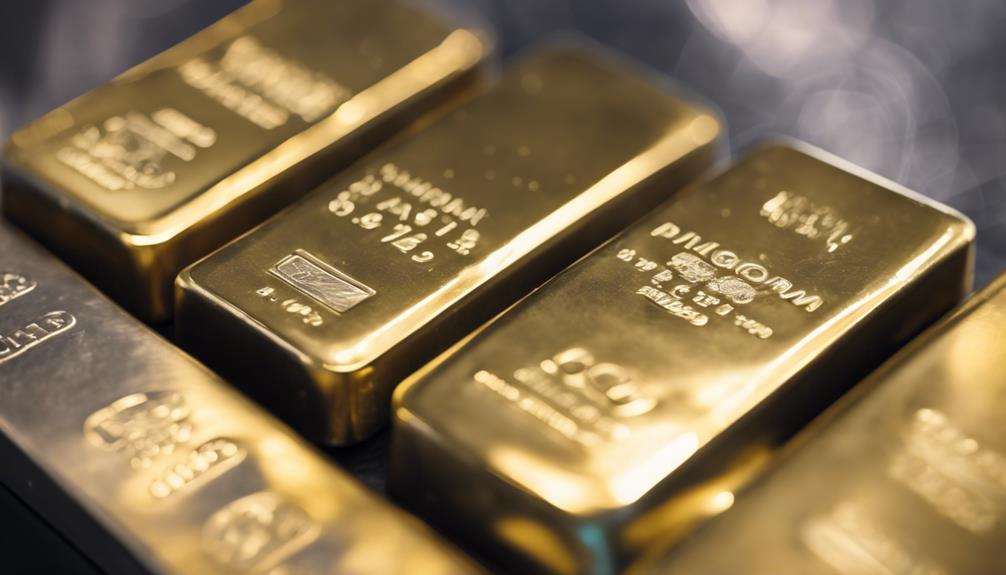
When considering precious metals for your IRA, it's important to be mindful of the approved metal weights. Understanding the limits and quantities accepted by IRA regulations is vital for making informed investment decisions.
Clarifying the weight requirements guarantees that your chosen metals align with the guidelines set forth for a Precious Metals IRA.
Metal Weight Limits
The approved metal weight limits for individual retirement accounts (IRAs) dictate the acceptable weights for precious metals like gold, silver, platinum, and palladium. For gold, allowable weights range from 1/10 ounce to 400 ounces. Silver is accepted in weights from 1/10 ounce to 1,000 ounces. Platinum has weight limits from 1/10 ounce to 50 ounces, while palladium ranges from 1/10 ounce to 100 ounces.
Gold must be 99.5% pure, silver 99.9%, and platinum/palladium 99.95% to qualify for an IRA. Specific IRA-approved gold coins include American Eagle, Australian Kangaroo, Austrian Philharmonic, and U.S. Buffalo coins meeting purity requirements. Similarly, acceptable silver coins encompass American Eagle, Australian Kookaburra, British Britannia, and Mexican Libertad, meeting the minimum purity standards for IRAs. IRA-eligible platinum coins like American Eagle, Australian Koala, and Isle of Man Noble must have a fineness of 99.95%, along with palladium coins like Canadian Maple Leaf.
IRA Approved Quantities
Exploring the permissible quantities for precious metals within an Individual Retirement Account (IRA), what are the approved metal weights worth taking into account? When considering precious metals for your IRA, it's important to follow the approved weights to guarantee compliance. Below is a breakdown of the acceptable weights for different types of precious metals:
| Metal Type | Maximum Weight Allowed |
|---|---|
| Gold Bars | Up to 400 ounces |
| Silver Bars | Up to 1,000 ounces |
| Platinum Bars | Up to 50 ounces |
| Palladium Bars | Up to 100 ounces |
Remember that smaller bullion bars must meet specific weight requirements to be eligible for inclusion in your IRA. Additionally, proof coins must be in their original mint packaging to qualify for IRA eligibility.
Weight Requirements Clarified
To further understand the weight requirements for IRA-approved precious metals, it is vital to take into account the specific weights allowed for various types of metals. Eligible weights include 1/10 oz, 1/4 oz, 1/2 oz, and 1 oz for gold and silver, while foreign coins should be carefully verified to confirm they meet IRA standards.
Gold bars up to 400 oz, silver bars up to 1,000 oz, platinum bars up to 50 oz, and palladium bars up to 100 oz are permissible in IRAs. Smaller bullion bars must meet exact weight specifications to be considered for IRA inclusion.
Understanding these weight requirements is essential for compliance and making informed investment decisions within your IRA.
Adding Metals to Self-Directed IRA
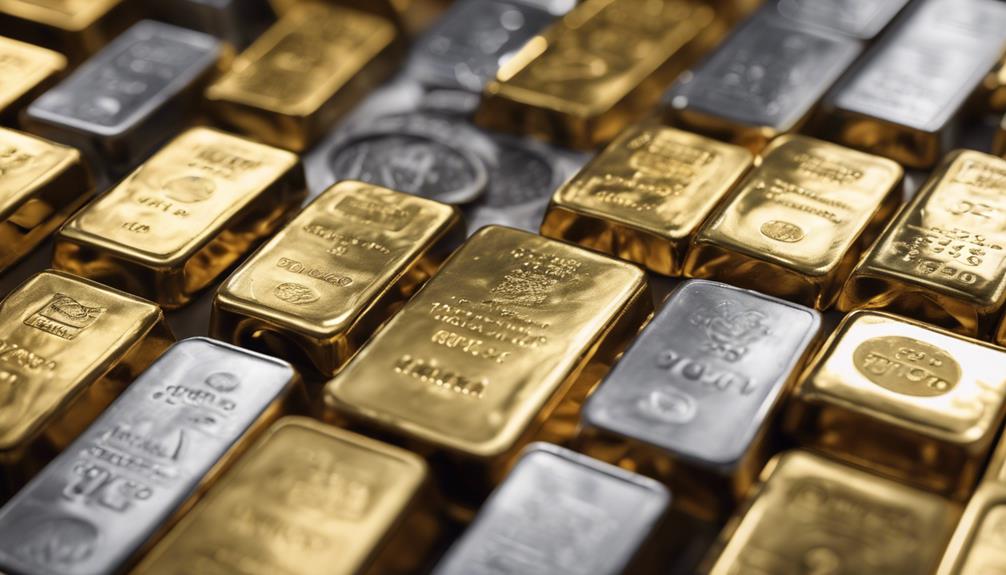
How can one effectively incorporate precious metals into a self-directed IRA for the best investment diversification?
To add metals to your self-directed IRA, it is essential to establish an IRA with a recommended Trustee/Custodian who can facilitate the process. Once you have designated Monex as your precious metals dealer, you can fund your account through the IRA Trustee/Custodian to invest in IRA eligible precious metals products.
It is important to invest in metals that meet IRA eligibility criteria to guarantee compliance with regulations governing self-directed IRAs. The metals you choose must adhere to these criteria to be considered valid investments within your IRA.
Once the process is initiated, the metals will be shipped, and payment will be made from the IRA accordingly. By following these steps and working with trusted professionals, you can effectively add precious metals to your self-directed IRA, enhancing your investment portfolio with valuable diversification options.
Precious Metals IRA Providers
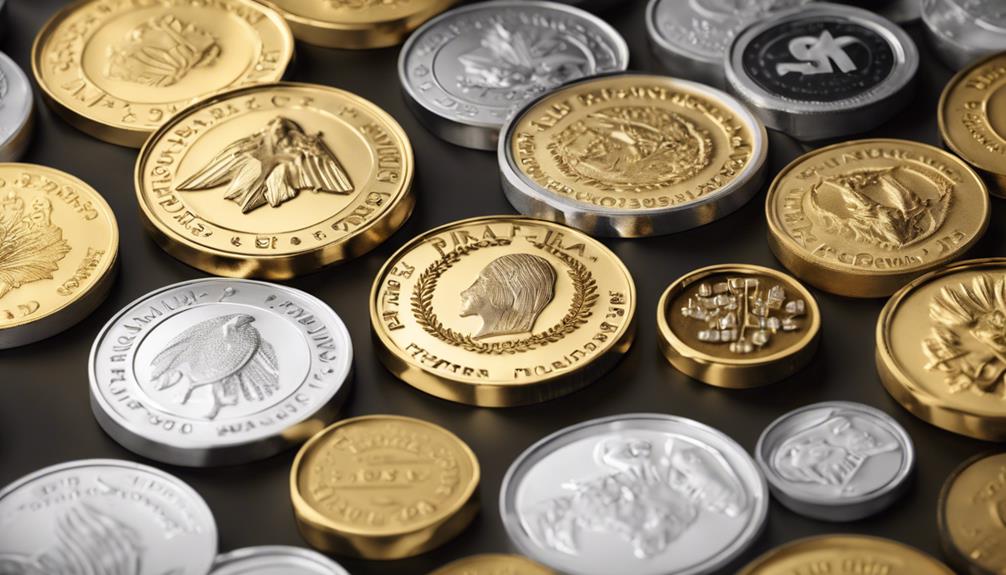
Among the reputable providers in the field of Precious Metals IRAs, GMRgold stands out as a trusted option for investors seeking to diversify their portfolios with precious metals. GMRgold offers a seamless process through a user-friendly Application Wizard for opening a Precious Metals IRA.
Clients have the flexibility to name GMRgold as the Broker Dealer during the setup process by using the provided dealer number. For those looking for a reliable IRA custodian, Equity Trust Company is a well-known and trusted option for holding Precious Metals IRAs securely.
With GMRgold, investors can guarantee that their chosen precious metals for the IRA are stored at a Federally Insured Depository until needed, providing peace of mind regarding the safety of their physical assets within the Self-directed IRA.
Diversifying IRA With Metals

Adding approved precious metals to your IRA can enhance portfolio diversification and strengthen investment resilience. Diversifying your IRA with metals like gold, silver, platinum, and palladium can provide a balanced approach to wealth management. These metals offer stability and serve as a hedge against market volatility and economic uncertainty. By incorporating a mix of gold, silver, platinum, and palladium into your IRA, you spread risk across different asset classes, reducing the impact of any one investment's performance on your overall portfolio. This diversification strategy helps protect your savings and potentially increase long-term growth opportunities. Investing in a variety of precious metals through a Precious Metals IRA can offer tax advantages and safeguard your retirement savings from the fluctuations of traditional financial markets. Consider the table below for a quick comparison of the key features of gold, silver, platinum, and palladium:
| Metal | Value Stability | Industrial Use | Investment Demand |
|---|---|---|---|
| Gold | High | Limited | Strong |
| Silver | Moderate | Extensive | Growing |
| Platinum | Moderate | Extensive | Stable |
| Palladium | High | Limited | Increasing |
Frequently Asked Questions
What Are the IRS Rules for Precious Metals Ira?
IRS rules for Precious Metals IRAs stipulate that gold must be 99.5% pure, silver 99.9%, and platinum/palladium 99.95%. Precious metals must originate from accredited refiners or mints to qualify. Gold investments require 24-karat bullion bars, while silver must come from an approved list.
IRA-approved weights range from 1/10 ounce to 1 ounce for coins and specific weights for bars. Adhering to these guidelines guarantees compliance with IRS regulations for Precious Metals IRAs.
How to Convert IRA to Precious Metals?
To convert an IRA to precious metals, make sure you have a valid IRA and available cash. Follow a streamlined process, like the one by Scottsdale Bullion & Coin, typically involving six steps.
Choose IRS-approved precious metals meeting purity requirements. For detailed information, consult IRS publications 590-A & 590-B.
Seek expert guidance through 1-888-812-9892 or the live chat option to explore the benefits of adding precious metals to your investment portfolio.
What Precious Metals Are Eligible for Ira?
Various precious metals are eligible for IRAs, including gold, silver, platinum, and palladium. Gold coins like American Eagle Bullion and Australian Kangaroo/Nugget, along with silver coins such as American Eagle Bullion and Australian Kookaburra, meet IRA qualifications.
Additionally, platinum coins like American Eagle and palladium coins like Canadian Maple Leaf can be included in IRAs if they meet specific fineness requirements. Bars of these metals are also accepted for IRA investment up to certain weights.
What Is Ira-Eligible for Platinum?
In an Individual Retirement Account (IRA), platinum investments must meet a minimum fineness of 99.95%. Approved platinum products include American Eagle coins, Australian Koala coins, Isle of Man Noble coins, and platinum bars with a minimum purity of 99.95%. These products adhere to the specific purity standards required for IRA eligibility.
Platinum bullion bars weighing up to 50 ounces can be added to a precious metals IRA, offering investors a range of options for diversifying their retirement portfolios.
Are Palladium and Other Precious Metals Besides Gold Approved for IRA Investment?
Yes, palladium and other precious metals besides gold are indeed gold IRA approved metals. This means that investors can include these metals in their retirement accounts as part of a diversified investment strategy. It’s important to consult with a financial advisor to understand the specific rules and regulations around investing in these metals through an IRA.
Conclusion
To sum up, diversifying your IRA with approved precious metals such as gold, silver, platinum, and palladium can provide a hedge against economic uncertainties. These metals offer tangible value and a potential safeguard against inflation.
Consider the benefits of adding these metals to your self-directed IRA to enhance your portfolio's stability and potential for growth. Are you ready to secure your financial future with precious metals in your IRA?
